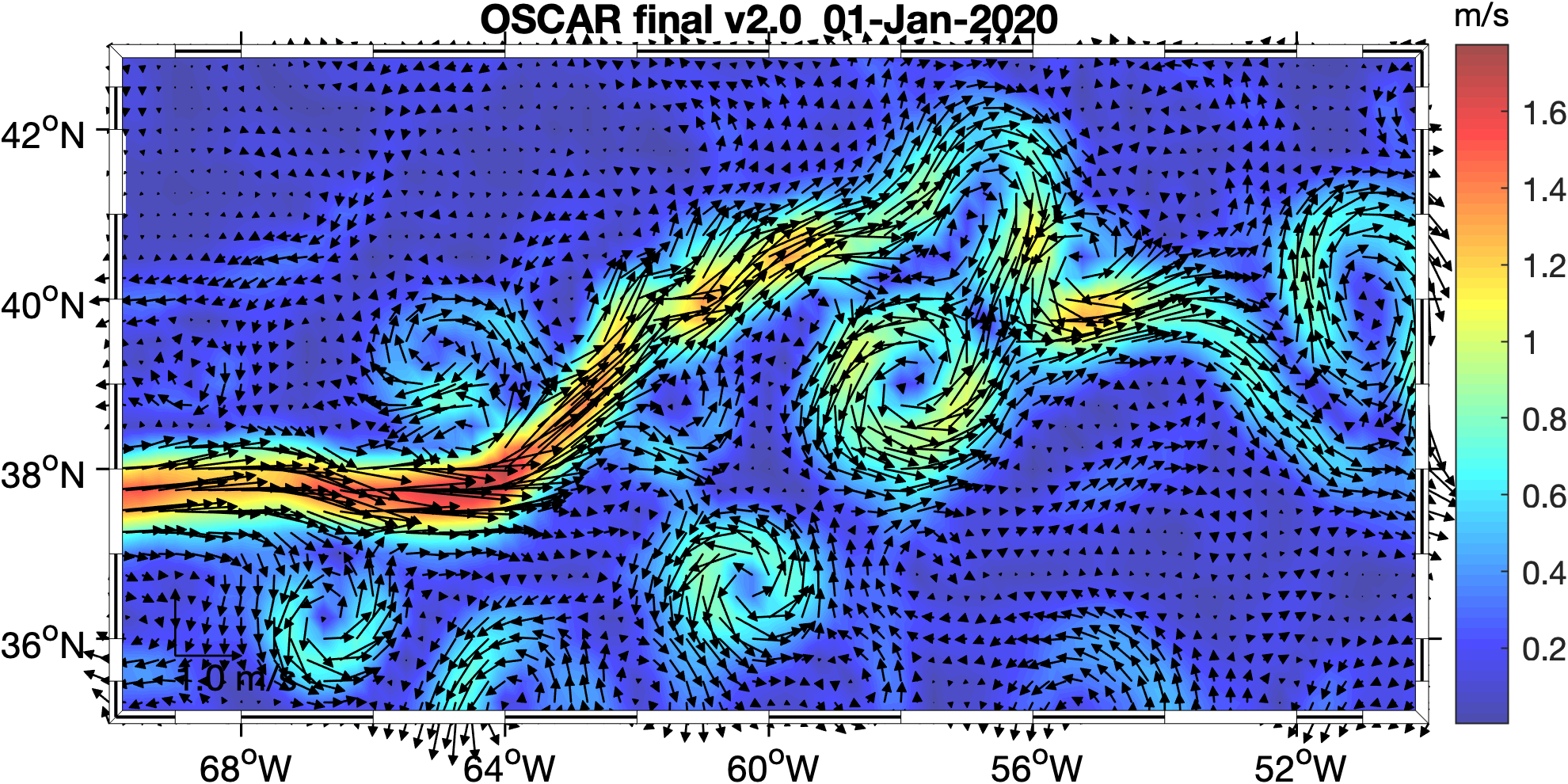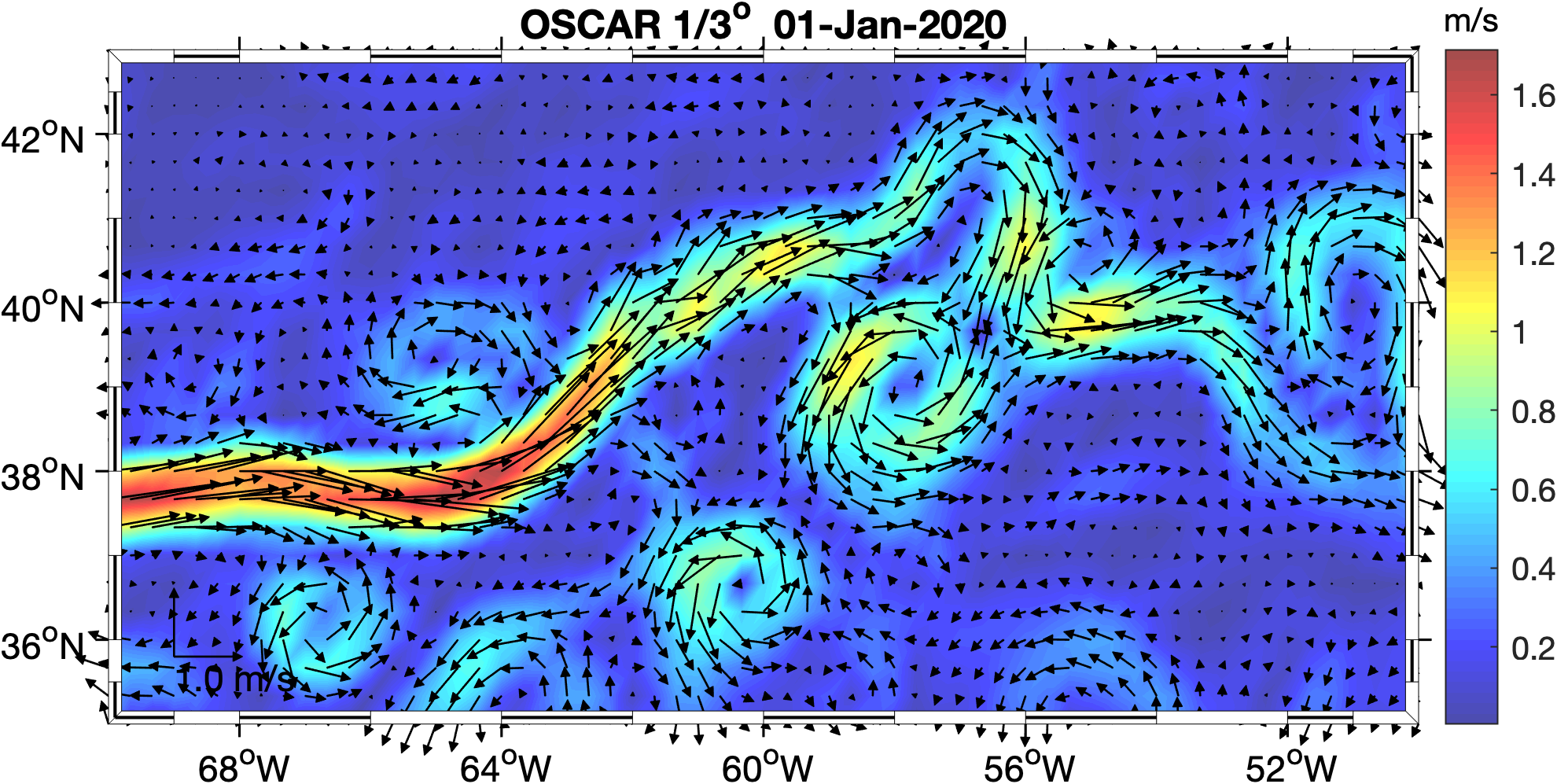Ocean Surface Current Analyses Real-time (OSCAR) is a NASA funded research project and global surface current database. The OSCAR ocean surface mixed layer velocities are calculated from satellite-sensed sea surface height gradients, ocean vector winds, and sea surface temperature fields using geostrophy, Ekman, and thermal wind dynamics.
OSCAR’s continuing improvement depends on better modeling of the momentum transfer both within and across the boundaries of the turbulent mixed layer. A main research objective of the OSCAR project is to improve the generation of surface currents by ocean vector winds, and in doing so further our understanding of the mechanisms behind the transfer of momentum between the atmosphere and the ocean through the planetary boundary layer.
OSCAR v2.0
We released OSCAR version 2.0 through the NASA JPL Physical Oceanography data center, PO.DAAC, in January 2022 (https://podaac.jpl.nasa.gov/dataset/OSCAR_L4_OC_INTERIM_V2.0, Dataset “Ocean Circulation”). In this v2.0, OSCAR is provided as daily files in NetCDF format that contain total zonal (u) and meridional (v) velocities as well as the zonal (ug) and meridional geostrophic (vg) components.
The data is available in three quality levels: final, interim, and near-real-time (nrt). The quality levels are determined by the best available source datasets and are intended to provide users with the best quality data while still producing near-real-time data.
The manual provides more detailed information about OSCAR, such as the data format, coverage, how to cite, etc., and is either found on the on the PO.DAAC dataset page or can be downloaded here: oscarv2.0guide.pdf. Answers to many questions about the PO.DAAC in general, the user registration system, how to retrieve data, specific questions about datasets themselves, and user shared scripts can both be found and posted on the PO.DAAC forum.
This new version is stored in the cloud. Information about access to PO.DAAC datasets in the cloud can be found here: https://podaac.jpl.nasa.gov/cloud-datasets/about.
Retirement of OSCAR third degree and 1 degree datasets
Please be informed that the OSCAR third degree and 1 degree datasets will be retired from PO.DAAC in April 2024. The datasets to be retired are:
- OSCAR_L4_OC_third-deg
- OSCAR_L4_OC_third-deg_YEARLY
- OSCAR_L4_OC_1deg
Users are encouraged to use the newest version, OSCAR Version 2.0, which provides daily files for the surface currents on a quarter degree grid. OSCAR Version 2.0 is available in three latencies below:
https://podaac.jpl.nasa.gov/dataset/OSCAR_L4_OC_FINAL_V2.0
https://podaac.jpl.nasa.gov/dataset/OSCAR_L4_OC_INTERIM_V2.0
https://podaac.jpl.nasa.gov/dataset/OSCAR_L4_OC_NRT_V2.0
Comparison of OSCAR v2.0 and older datasets
In the previous versions, surface currents were provided on a regular global grid every ~5 days, dating from 1992 to present day, with daily updates and near-real-time availability in yearly files. OSCAR currents were on either 1 degree and 1/3 degree grid spacing in NetCDF format.
This table summarizes the differences in the structure of the v2.0 dataset:
| older OSCAR | v2.0 OSCAR | |
| sample filename | oscar_vel2024.nc | oscar_currents_nrt_20240315.nc |
| latitude variable | latitude | lat |
| latitude span | 80:-0.333:-80 | -89.75:0.25:89.75 |
| longitude variable | longitude | lon |
| longitude span | 20:0.333:420 | 0:0.25:359.75 |
| time | days since 1992-10-05 | days since 1990-01-01 |
| time step | ~5 days | daily |
| velocity structure | u(time,depth,latitude,longitude) | u(time,longitude,latitude) |
Details about the source data used in each file is now provided in the metadata for each file.
Sample plots of Gulf Stream rings comparing the new v2.0 to the OSCAR 1/3 degree are shown below.


